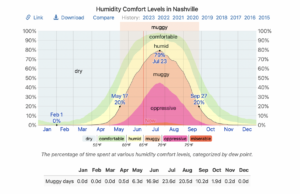One of the biggest challenges faced by building scientists in Middle Tennessee is humidity — especially in the summer. Humidity has major implications for comfort, durability, and health. To understand why this is such a concern, consider this key concept: dew point.
What Is Dew Point and Why Should You Care?
The dew point is the temperature at which air becomes fully saturated with moisture — meaning it cannot hold any more water vapor. When air cools to this temperature or encounters an object that is below this temperature, condensation occurs.
During Middle Tennessee summers, it is common for the outdoor dew point to reach the low-to- mid 70s (°F). This is a diagram of dew point temperatures from weatherspark.com showing on average what percentage of the time the dewpoint is at a given temperature through the course of the year. You can see that during July and August it is above 65°F for more than 60% of the time and above 70°F for more than 30% of the time.

Consider this: many of us set our home thermostats to around 68–75°F during cooling season. This is coincidentally right around the dewpoint of outside air for most of the summer. So when that humid outside air leaks into your home and cools down the temperature of the house, moisture may start accumulating inside your building materials.
Why That’s a Problem
Most building materials are porous — they absorb moisture instead of showing visible puddles. Even if you don’t see liquid water, condensation is happening inside the structure. Building material will accumulate moisture over the course of the summer and when moisture levels get high enough, you get the perfect conditions for mold growth. This is difficult to predict since it depends on so many variables like the weather, the infiltration rate of the house, thermostat set point, and the hygric capacity of the building materials – but it is important to know that we in Middle Tennessee hover around the tipping point for a few months each year.
In the Middle Tennessee region, homes often hover on the edge of a moisture crisis. A small change in your thermostat setting can tip the balance. The longer you keep your thermostat below the dew point, the greater the risk of growing mold.
Thermostat Settings: A Hidden Risk
Let’s break it down:
- At a 75°F thermostat setting, your home will only occasionally dip below the outdoor dew point — so condensation is infrequent.
- If you drop the setting between 70 and 75°F degrees, the risk will gradually rise. In July and August, the outdoor dew point is above 70°F for 30-45% of the time. So, you will get some crossover with the dewpoint, but it is not constant.
- If your thermostat is set below 70 you will be below the dew point for over 70% of the time in July and more than 60% of the time in August. This is a real big jump in the risk of growing mold.
It is very surprising how such a small change in something as basic as the thermostat set point can have such a big effect on the health of a building and the people in it.
The “Ideal Sleeping Temp”— And The Local Reality
A growing trend promoted by wellness sites and health professionals — including WebMD — says the ideal temperature for sleeping is 60–65°F. That may work well in a controlled lab or dry climate, but it can be a serious problem in humid areas like Middle Tennessee. You do not want to trade one health problem for another, so it is best not to follow this advice in the summer months. In the winter, the dew point is much lower, so it is safe to keep the house at a lower temperature.
Ways to Mitigate the Risk of Growing Mold in the Cooling Season
For most homeowners, this risk can be managed with behavioral changes:
- Keep track of the dew point from May till September and make sure your thermostat stays above it. If you don’t want to track it just keep the thermostat at 75°F or higher.
- If you need cooler temperatures at night use a programable thermostat that allows the temperature to go back up during the day. This will reduce the amount of time that moisture is accumulating but not completely prevent it.
- Use ceiling fans to make it feel cooler in the house. Do not run your HVAC fan on continuous as this can lead to higher humidity.
- Wear cooler clothes, avoid hot foods and drinks, and lower the temperature of the shower.
If you have a medical need to sleep in cooler temperatures, or you just can’t bear 75 degrees in the house, there are some improvements you can make to you house that will allow you to get it cooler while minimizing risk:
- Reduce other moisture loads on the house. The most common examples are crawlspace encapsulation and proper bathroom and kitchen exhaust.
- Reduce Air infiltration as much as possible with special attention on avoiding negative pressures.
- Make sure your HVAC system is properly sized so that it can manage humidity better.
- Add a whole-house dehumidifier. Dehumidifiers are the only way to actively manage humidity. Keeping humidity down in the house will pull moisture out of the building materials and make the house feel more comfortable at a higher temperature.
- Add a mechanical ventilation that is either balanced or positive pressure. Adding mechanical ventilation will allow you to bring in air from outside without bringing it through the building assembly where condensation can occur.
These measures are best incorporated into the design of the home before it is built, but they can also be retrofitted on an existing home. These fixes are significant investments, but they will make you house healthier, more comfortable, more durable and energy efficient.
In the summer in Middle Tennessee, your thermostat setting is about more than comfort — it is about protecting your home from hidden moisture damage. The lower you go below the dew point and the longer you stay there, the higher the risk.
When in doubt? 75°F is a safe bet. Below 70°F, you’re asking for trouble — unless your home is purpose-built to handle it.









